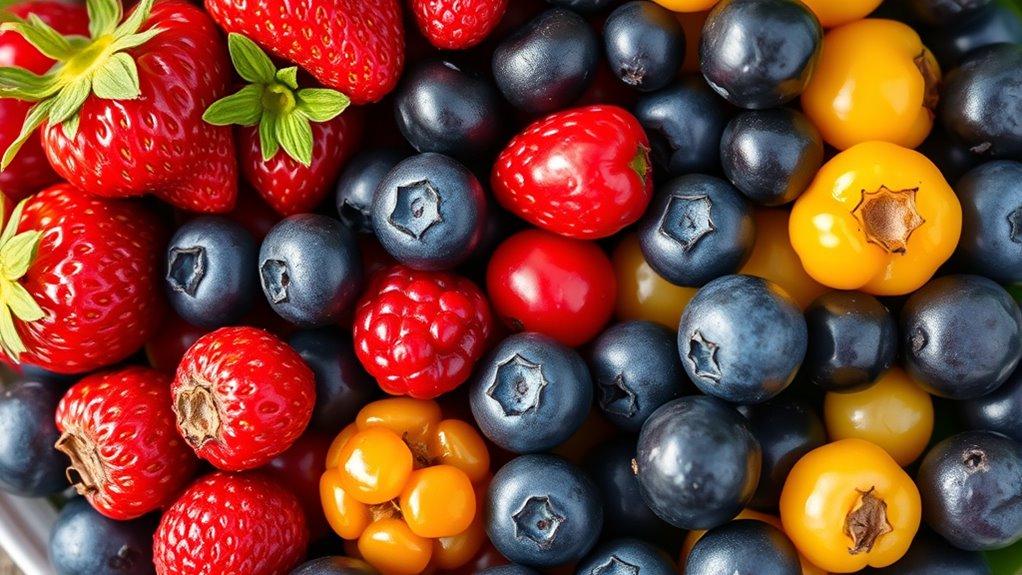Your forager’s color wheel helps you spot safe berries by their hue, which signals ripeness and edibility. Bright reds often mean ripe, edible berries like strawberries, while deep blues and purples indicate sweetness. However, beware that some toxic berries mimic these hues, so always confirm shape and stem details. Understanding how different colors relate to safe and dangerous options keeps you cautious. Keep exploring to master the full spectrum of berry colors and avoid dangerous doubles.
Key Takeaways
- Use berry hue as an initial indicator but always confirm with shape, stem attachment, and size to avoid toxic look-alikes.
- Recognize that bright red or deep blue colors often signal ripeness, but some toxic berries mimic these hues.
- Be aware that certain toxic berries (e.g., pokeweed, bittersweet) share similar colors with edible varieties, requiring careful identification.
- Cross-reference berry color with other plant features and consult field guides or experts to prevent dangerous mistakes.
- Understanding the natural significance of berry colors helps distinguish safe, ripe berries from potential hazards.

Have you ever wondered how foragers identify the vibrant colors of wild plants and mushrooms? It’s a skill that combines keen observation with a deep understanding of nature’s cues. When it comes to berries, color plays a vital role in distinguishing edible berry varieties from their toxic look-alikes. The berry color significance isn’t just about aesthetics; it’s an essential clue that guides you toward safe, delicious finds or warns you to steer clear. Bright reds, for example, often signal ripe, edible berries like strawberries or raspberries, but sometimes, they can also point to poisonous counterparts. That’s why knowing which berry hues indicate safe options—and which are dangerous—is crucial for any forager.
Understanding the vibrant spectrum of berries helps you develop a mental map that filters out risky look-alikes. For instance, many edible berries are deeply pigmented—think blackberries or blueberries—whose dark hues often suggest ripeness and sweetness. Conversely, some berries with bright orange or yellow colors, such as certain honeysuckles or bittersweet nightshades, can be toxic or mildly poisonous. The berry color significance extends beyond surface appearance; it’s intertwined with the plant’s natural ripening process. Many berries change color as they mature, signaling their readiness to be picked. Recognizing these subtle shifts in hue ensures you harvest at peak flavor and safety.
Deeply pigmented berries like blackberries signal ripeness, while bright orange or yellow hues may indicate toxicity.
However, relying solely on color isn’t enough. Foragers learn to observe the shape, size, and stem attachment of berries, but hue remains a quick and effective initial filter. When you spot a cluster of berries, note their color first. If they’re a vibrant red, double-check the plant’s identity—some red berries like pokeweed are highly toxic, despite their appealing hue. Blue or black berries often indicate ripeness in edible varieties, but some poisonous plants mimic these colors too. That’s why understanding the context and other plant features is vital. Additionally, foraging safety involves awareness of local plant varieties and potential look-alikes to avoid accidental poisoning.
The berry color significance is rooted in evolutionary adaptations—plants use color to attract certain animals that help disperse their seeds. As a forager, you’re tapping into this natural language. Recognizing which colors indicate ripeness and safety helps you avoid dangerous doubles that mimic edible berries but harbor toxins. Never rely solely on color; always cross-reference with other identifying features and, when in doubt, consult reliable field guides or experts. Developing an eye for these details turns berry picking into a safer, more rewarding experience, allowing you to enjoy nature’s bounty without risking your health.
Frequently Asked Questions
How Can I Distinguish Edible Berries From Toxic Lookalikes?
To distinguish edible berries from toxic lookalikes, you should look for toxic berry indicators like unusual colors, bitter tastes, or milky sap. Always use edible berry guides to verify the species before consuming. Pay attention to shape, size, and growth patterns, and avoid berries with dull or uneven hues. When in doubt, it’s safest to avoid eating wild berries unless you’re confident in your identification skills.
Are There Color Variations in Berries Across Different Regions?
You’ll notice regional berry diversity influences color variation patterns, meaning berries of the same species can look different depending on where you are. This regional variation helps you identify edible berries more accurately, but stay cautious, as lookalikes might also change hue across regions. Familiarize yourself with local berry varieties and their typical color patterns to avoid confusion and guarantee safe foraging wherever you go.
What Seasonal Changes Affect Berry Coloration and Identification?
Seasonal changes considerably impact berry coloration through seasonal pigmentation and environmental influences. As seasons shift, you’ll notice berries change hue, signaling ripeness or caution. For example, many berries turn brighter or deeper in color during summer, indicating peak ripeness, while environmental factors like sunlight, temperature, and soil nutrients also influence their shades. Recognizing these natural cues helps you accurately identify safe berries and avoid dangerous doubles.
Can Berry Color Change Indicate Ripeness or Toxicity Levels?
Think of berry color like a story in progress—your clues to ripeness or toxicity. As the berry’s pigmentation evolves, it signals readiness or danger. Bright, vibrant hues often indicate ripeness, but beware—color changes can also warn of toxicity. You should observe the color evolution carefully, knowing that a shift in hue might mean the berry is either at its prime or perilous to eat. Always verify before harvesting.
Are There Tools or Apps to Assist With Berry Identification by Hue?
You might wonder if digital identification tools or mobile apps can help you identify berries by hue. Many apps now use your phone’s camera for real-time analysis, matching berry colors to a database of safe and toxic varieties. These tools offer quick, visual guidance, making foraging safer and more efficient. Just remember, always verify with multiple sources and avoid relying solely on color, especially in complex environments.
Conclusion
By mastering the forager’s color wheel, you can confidently identify safe berries and avoid dangerous look-alikes. Remember, studies show that nearly 30% of wild berries are mistaken for toxic ones, highlighting the importance of accurate identification. By paying attention to hue, you reduce your risk of poisoning and enjoy nature’s bounty safely. So next time you’re out, trust your color cues—your safety and taste buds will thank you!










